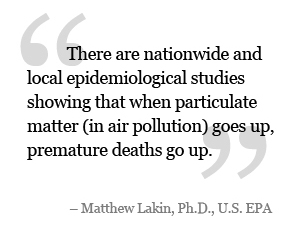A Lack of Natural Gas Service is No Longer an Excuse for Wood Burning
Many rural areas in the US still lack natural gas service, and these areas often have the highest rates of residential wood burning (and the highest wintertime air pollution).
The reliance on wood burning for home heating in these areas is rationalized on the basis that the cost of electric heat or propane is too expensive. This rationale has even held sway with air quality regulators, who have exempted areas not serviced with natural gas from wood burning restrictions on days when the air quality is poor or predicted to be poor (see, for example, the policies of the San Joaquin Valley and the San Francisco Bay Area Air Districts).
But now, thanks to advances in technology, heating a home with an electric split ductless heat pump is cheaper than heating with natural gas (see here, here, and here). Sensiblenergy.com provides a detailed four-part comparison of the cost of heating a moderate-sized house in Portland, Oregon using gas vs. oil vs. electricity. (Part 4 is here with links to the other parts.) The conclusion? Using a split ductless heat pump is the cheapest of these options.
Split ductless heat pumps are extremely efficient because they move heat from one place to another rather than generating heat from energy. (A more detailed explanation of how they work can be found here.) Installation does not require ductwork, which can be expensive and difficult to put in. In fact, the cost to purchase and install a split ductless unit is comparable to the purchase and installation of a wood stove. Note that these units can cool as well as heat–try doing that with a wood stove.
Wood burning is one of the most damaging activities an individual can do in terms of the impact on the health of their neighborhood. Now there’s one less excuse for doing it.
Study Shows Wood Smoke Pollution Levels Vary Widely Within a Neighborhood
Proving once again the real estate mantra, “Location, Location, Location,” an important new study raises serious concerns that wood smoke pollution at some residential locations is much higher than previously estimated. Specifically, the study reports huge variations in the exposure levels to wood smoke at different locations within a single neighborhood.
In this well designed field study funded by the California Air Resources Board (CARB), researchers compared measurements of wood smoke pollution within a one-kilometer area of a small California coastal town. The sampling occurred on 15 nights over two winter seasons. Notably, the town has no significant sources of air pollution, such as traffic or industry, other than residential wood combustion.
The researchers found that there were large variations in wood smoke pollution levels even within this small area. How large? Measurements in some locations were up to 300% higher than the area average.
This means that people living in the same neighborhood are being exposed to radically different levels of hazardous air pollution—and that some unfortunate households are being exposed to much higher air pollution levels than shown by centrally located air monitors.
This study illustrates why central air monitoring, which reports the average particulate pollution at a single location, is not an effective tool for measuring wood smoke pollution.
It also lends urgency to the recent call by Utah Physicians for a Healthy Environment to ban wood burning in densely populated areas.
Families for Clean Air’s Comments on the New EPA Wood Burning Rule
The EPA’s proposed rule on wood burning devices has generated significant media attention, controversy, and misinformation (most of it created intentionally).
The public comment period on the proposed rule ended on May 5, 2014, and the EPA now has nine months to finalize the new rule (found here).
The proposed rule was issued in the wake of lawsuits brought by several states and public health organizations. The lawsuits charged that current federal standards were not adequately protecting people from the pollution produced by wood burning devices.
While Families for Clean Air appreciates that the proposed EPA rule addresses some shortcomings of the existing rule, serious concerns remain. You can find out what these concerns are by reading the comments that Families for Clean Air submitted to the EPA.
We urge you to give FCA’s comments a read.
Now’s the Time to Comment on the EPA Rule for Wood Burning Devices
As you’ve no doubt heard by now, the EPA is updating the regulations for wood heating devices for the first time in 25 years. The proposed EPA rule pertains to woodstoves, fireplace inserts, pellet stoves, hydronic heaters (a.k.a. outdoor wood boilers), forced air wood furnaces, and masonry fireplaces.
You can read more about the proposed rule here.
The EPA is accepting comments on the rule until Monday, May 5. If you feel the EPA should be doing more to protect public health and the environment from wood smoke pollution, now is the time to make your opinion known. You can be sure the folks who are against any government regulation of wood burning are weighing in on this issue – so make sure your voice is heard.
It’s fast and easy to comment–you can do it online right here.
Remember, you only have until May 5 to comment.
New Study: Current Particle Pollution Standards are Killing Us
For years, scientists and medical professionals have cautioned that the US standard for fine particle pollution is set too high to effectively protect human health. In the winter, wood burning is one of the leading contributors to particulate pollution.
A large European study recently published in the Lancet gives new credence to these claims. Notably, the European Union fine particle limit of 25 µg/m3 is already considerably more protective than the US standard of 35 µg/m3.
What this study shows is that even the lower EU standard is not low enough to adequately protect human health.
The study’s lead author Rob Beelen notes, “Our findings suggest that significant adverse health effects occur … well below the EU annual average air-quality limit value of 25 µg/m3.” Results from the study showed that the risk of natural death increases by 7% with each 5 µg/m3 rise in PM2.5 concentrations.
This large study looked at data from 22 European cohort studies conducted in 13 European countries to investigate the link between natural-cause mortality and long-term exposure to air pollution. Almost 370,000 participants were monitored for an average of 14 years. Note that the analyses controlled for socioeconomic, health, and lifestyle factors such as income and smoking, which are known to influence mortality.
According to Beelen, “The World Health Organization air-quality guideline is 10 µg/m3, and our findings support the idea that significant health benefits can be achieved by moving towards this target.”
This study brings new urgency to the need to lower the fine particle pollution standard in the US. Also, given the fact that in many communities wood burning is the largest source of wintertime fine particle pollution, the study makes it clear why it is so important to eliminate wood burning pollution.





